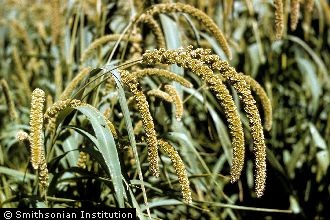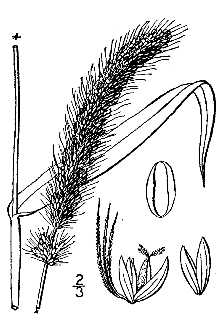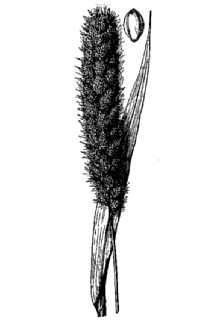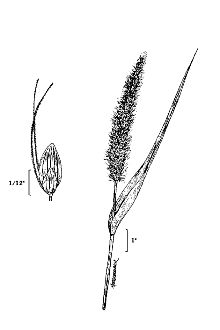Setaria italica (L.) P. Beauv. var. stramineofructa (F.T. Hubbard) L.H. Bailey
Scientific Name: Setaria italica (L.) P. Beauv. var. stramineofructa (F.T. Hubbard) L.H. Bailey
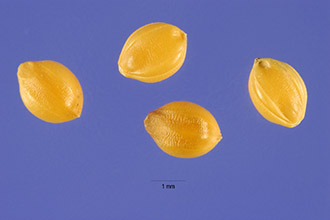
| General Information | |
|---|---|
| Usda Symbol | SEITS |
| Group | Monocot |
| Life Cycle | Annual |
| Growth Habits | Graminoid |
| Native Locations | SEITS |
Plant Guide
Alternate Names
Common Names: Italian millet, Italian foxtail, German millet, Siberian millet, foxtail bristlegrass, foxtail-millet Scientific Names: Panicum italicum L., Setaria italica (L.) P. Beauv. var. stramineofructa (F.T. Hubbard) L.H. Bailey,Setaria italica (L.) P. Beauv. var. metzgeri (Koern.) Jáv., Setaria italica (L.) P. Beauv. subvar. metzgeri (Koern.) F.T. Hubbard,Chaetochloa italica (L.) Scribn.
Description
General: Foxtail millet (Setaria italica) is thought to be native to southern Asia and is considered one of the oldest cultivated millets (Oelke, 1990). It is an introduced, annual, warm-season crop that grows 2–5 ft (60-152 cm) tall. The stems are course and leafy, and more slender than those of pearl millet (Pennisetum glaucum) (Lee and Henning, 2014). It can form one or more tillering shoots (Dekker, 2009). The yellowish or purplish, 8-in (20-cm) nodding inflorescence is composed of a main stalk with many side branches. The seedheads are dense and bristly (Cash et al., 2002) and the oval, convex seed grain can be a variety of colors. Distribution: Foxtail millet is grown in cooler, droughtier regions than other millets (Koch, 2002). It is widely grown throughout China, India, Russia, Africa, and the United States. In the United States, foxtail millet is mainly grown in the northern and western Great Plains, Midwest, the Dakotas, Colorado, Kansas, Nebraska, and Wyoming (Oelke, 1990; Baltensperger, 1996). For current distribution, please consult the Plant Profile page for this species on the PLANTS Web site. Habitat: In most areas foxtail millet is a facultative upland plant (FACU) that usually occurs in non-wetlands but may occur in wetlands. In the Caribbean it almost never occurs in wetlands.
Adaptation
It can grow in sandy to loamy soils with pH from 5.5–7. It will grow rapidly in warm weather and can grow in semi-arid conditions, however, it has a shallow root system that does not easily recover from drought (Hancock Seed, 2014). It can produce one ton of forage on 2 ½ in of moisture and requires approximately 1/3 less water than corn (Koch, 2002). It has a high level of tolerance to salinity (Krishnamurthy et al., 2014). It can grow at higher elevations (1500 m) as well as in plains (Baltensperger, 1996).
Uses
Forage/Feed: In the United States, foxtail millet is primarily grown for hay. Foxtail millet does not produce as much biomass as pearl millet, but can produce 1–3.5 tons/ac of aboveground biomass (AGB) (Shonbeck and Morse, 2006) and can only be cut once (Lee and Henning, 2014). Like all millets, this species is fast-growing and produces relatively high yields with no danger of producing toxic levels of prussic acid (Lee and Henning, 2014). However, avoid feeding livestock foxtail millet if the plants have been severely stressed, as they may accumulate high levels of nitrate (Oelke, 1990). Foxtail millet can be harvested 75–90 days after planting (DAP) (Cash et al., 2002). It can produce good quality hay when gathered into windrows and left until fall/winter grazing (Koch, 2002). Due to its fast growth, it can be used as an emergency hay crop (Oelke, 1990). It is easy to harvest as hay because of its short, fine stems. Hay harvesting can begin at boot stage, when seedheads are beginning to emerge, or from late boot to early bloom stage for optimum quality (Cash et al., 2002). Foxtail millet may act as a laxative to horses unless the hay is mixed with other roughage (Oelke, 1990), and can damage a horse’s liver, kidneys, and bones due to the glucoside setarian (Anderson and Volesky, 2013). Foxtail millet lacks some essential vitamins and nutrients for swine production purposes, so should be mixed with other materials for a complete feed. Further information regarding these nutrients can be found in Oelke (1990). Foxtail millet is similar to other warm-season grasses in terms of forage quality (Baltensperger, 1996). It performed as well as corn in broiler chicken diets and could replace 100% of corn in broiler feed without negatively affecting protein digestibility or bird health (Boroojeni et al., 2011). Natural Resources Conservation Service Plant Guide Cover crop/green manure: Like Japanese millet (Echinochloa esculenta), foxtail millet can be used as a weed-suppressing smother crop. It can be useful as a dead-standing winter cover, or to help suppress weeds when used in rotation after winter wheat (Koch, 2002). It has a C:N ratio of 44 and can produce 43 lb/ac N in aboveground biomass (Creamer and Baldwin, 1999). Its water-use efficiency is one of the highest of any crop, thus making it a good choice for use in semi-arid environments (Koch, 2002). Mixing foxtail millet with cowpea (Vigna unguiculata) is a good cover crop option (Creamer and Baldwin, 1999). When foxtail millet was used in Maryland in a cover crop mixture with soybean prior to fall-planted broccoli, the soybean and millet mix suppressed more weeds than the millet alone, had a larger total N, and had similar above-ground biomass (Abdul-Baki et al., 1997). Sugar snap peas (Pisum sativum) planted with a no-till drill grew well in senescing millet in the Mid-Atlantic region (Myers et al., 2000); however, Vollmer and others (2010) had less success planting no-till onions into millet residue in North Carolina due to the thickness of the residue. Foxtail millet residue is more persistent than other residue like soybean and buckwheat, probably because of its high C:N ratio (Morse, 1995). It can be terminated by winter-kill, mowing, or rolling with a crimper during the green seed stage (Creamer and Baldwin, 1999). Critical Area Stabilization: Because foxtail millet is fast-growing and produces more biomass than annual rye, it is sometimes the preferred choice for restoration of mine lands or steep slopes (Burger et al., 2009). Wildlife: Many granivorous birds are attracted to millet and it is often included in finch and exotic birdseed mixes. It is also planted in food plots for deer, turkey, quail, and dove (Hancock Seed Co., 2014).
Ethnobotany
Foxtail millet has a long history of cultivation for human consumption in China dating back to the Neolithic Era over 4,000 years ago (Baltensperger, 1996). It is the most important millet species currently grown in China (Baltensperger, 1996). It was once a staple crop in the northern Philippines and eventually lost its dominance to pond-field cultivation of rice and increased production of swidden plots of sweet potato (Bodner and Gereau, 1988). Along with pearl millet and finger millet, foxtail millet is one of the most important millets in the semi-arid tropics of Asia and Africa (CGIAR, 2014). In the United States, foxtail millet was not often or widely grown until after colonial times (Oelke, 1990).
Status
Weedy or Invasive: The Setaria genus as a whole include many invasive weeds that are known for their ability to quickly adapt to local conditions (Dekker, 2003). Foxtail millet can become weedy if it is allowed to produce seed. It is considered an invasive species in some regions in the United States, and its use is discouraged in Tennessee. Please consult with your local NRCS Field Office, Cooperative Extension Service office, state natural resource, or state agriculture department regarding its status and use. Please consult the PLANTS Web site (http://plants.usda.gov/) and your State Department of Natural Resources for this plant’s current status (e.g., threatened or endangered species, state noxious status, and wetland indicator values).
Planting Guidelines
Plant during late spring/early summer to ensure adequate yield. Soil temperatures should be at least 65°F before planting (Cash et al., 2002). It should be seeded ¼–½ in deep at 15–20 lb/ac drilled or 20–30 lb/ac broadcast in a well-prepared, firm seedbed (Hancock Seed, 2014). Applying fertilizer will help increase yields, but should be done in accordance with soil tests, and Cooperative Extension recommendations for soils/crops in the area.
Management
If controlling weeds through cultivation, plant foxtail millet in 30-in rows. If foxtail millet is terminated by roller-crimper without the use of herbicides, residue will be more persistent than soybean or buckwheat residue (Morse, 1995). There may be some disadvantage to leaving too much millet residue on the soil surface as it can impede subsequent cash crops or native vegetation recruitment in restoration projects (Burger et al., 2009). Like proso millet (Panicum miliaceum), there is little regrowth after cutting (Baltensperger, 1996). Livestock should only be allowed to graze the plant after it reaches 18 in, and before it begins to produce seed (Lee and Henning, 2014). Do not graze below 8 in. Generally pesticides are not used in production practices, so there are opportunities to grow millet for the organic feed market (Lee and Henning, 2014)
Pests and Potential Problems
Summer annual weeds are competitive with millets (Lee and Henning, 2014). One of the most effective ways of controlling weeds during establishment is to plant foxtail millet seed into a well-prepared, weed-free seedbed. Foxtail millet can be stunted or killed by Pyricularia leaf spot (Vollmer et al., 2010). Caution should be used when planting foxtail millet near wheat, as it is known to host the wheat curl mite, responsible for wheat streak mosaic virus (Anderson and Volesky, 2013). Millet may attract undesirable herbivores like rodents and deer that may browse tree seedlings in restoration sites (Burger et al., 2009).
Seeds and Plant Production
Plant Production
Plant Production
Foxtail millet is self-pollinated and will produce seed in 75–90 days (Hancock Seed, 2014). There is a very quick transition period from vegetative growth to flower-development (Baltensperger, 1996). Flowering occurs top-down on each of the stemmed branches. The seed yield of foxtail millet is similar to proso, but the seeds are smaller. It has approximately 230,000 seeds/lb
Literature Cited
Abdul-Baki, A,A,, R,D, Morse, T,E, Devine, J, R, Teasdale, 1997, Broccoli production in forage soybean and foxtail millet cover crop mulches, HortScience 32(5):836–839, Anderson and Volesky, 2013, Summer annual forage grasses, NebGuide # g2183, Univ, of Neb, Ext, Serv,, Univ, of Nebraska-Lincoln, Inst, of Ag, and Nat, Res, Baltensperger, D,D, 1996, Foxtail and proso millet, p, 182–190, In J, Janick (ed,) Progress in new crops, ASHS Press, Alexandria, VA, Bodner, C,C,, and R,E, Gereau, 1988, A contribution to Bontoc ethnobotany, Econ, Bot, 42(3):307–369, Boroojeni, F,G,, A,H, Samie, M,A, Edriss, M, Khorvash, G, Sadeghi, A, Van Kessel, and J, Zentek, 2011, Replacement of corn in the diet of broiler chickens using foxtail millet produced by 2 different cultivation strategies, Poultry Science 90(12): 2817– 2827, doi:10,3382/ps,2011-01647 Burger, J,, V, Davis, J, Franklin, C, Zipper, J, Skousen, C, Barton, and P, Angel, 2009, Tree-compatible ground covers for reforestation and erosion control, Forest Reclamation Advisory No, 6, Appalachian Regional Reforestation Initiative (ARRI), Cash, D,, D, Johnson, and D, Wichman, 2002, Growing millet in Montana, MSU Ext, Serv, http://www,co,yellowstone,mt,gov/extension/ag/pubs/millet,pdf (accessed 30 Jul, 2014), CGIAR, 2014, Crop factsheets: millets, Consultative Group on International Agricultural Research, Montpellier Cedex 5, France, http://www,cgiar,org/our-research/crop-factsheets/ (accessed 09 Sept, 2014) Creamer, N,G,, and K,R, Baldwin,1999, Summer cover crops, NC State Univ, Coop, Ext, Publication # HIL-37, http://www,ces,ncsu,edu/hil/hil-37,html (accessed 21 Aug, 2014) Dekker, J, 2003, The foxtail (Setaria) species-group, Weed Sci, 51(5):641–656, doi: http://dx,doi,org/10,1614/P2002-IR Hancock Seed Co, 2014, German foxtail millet seed, Hancock Seed Company, Dade City, FL, https://hancockseed,com/german-foxtail-millet-seed-5-lb-bag-638,html (accessed 30 Jul, 2014), Koch, D,W, 2002, Foxtail millet-management for supplemental and emergency forage, SMRR Info Source, Univ, of Wyoming, Krishnamurthy, L,, H, D, Upadhyaya, C, L, L, Gowda, J, Kashiwagi, R,, Purushothaman, S, Singh, and V, Vadez, 2014, Large variation for salinity tolerance in the core collection of foxtail millet (Setaria italica (L,) P, Beauv,) germplasm, Crop and Pasture Science 65(4): 353–361, http://dx,doi,org/10,1071/CP13282 Lee C, and J, Henning, 2014, Millet, Univ, of KY Coop, Ext, Serv,, College of Ag,, Food, and Env, Center for Crop Diversification, http://www,uky,edu/Ag/CCD/introsheets/millet,pdf, (accessed 3 Sept, 2014), Morse, R,D, 1995, No-till, no-herbicide systems for production of transplanted broccoli, p, 113– 116, In W,L, Kingery and N, Buehring (eds,) Conservation farming—a focus on water quality, Proc, South, Reg, Conserv, Tillage for Sustain, Agric,, Jackson, Miss, 26–28 Jun, 1995, Myers, R,D,, M, Spicknall, and A, Hawkins, 2000, Use soil moisture sensors to measure the soil moisture of Setaria italica (L.) P. Beauv. var. stramineofructa (F.T. Hubbard) L.H. Bailey., Planting sugar snap peas into German foxtail millet for pumpkin market synchrony without herbicides, Univ, of MD Coop, Ext,, Glen Burnie, MD, Oelke, E,A,, E,S, Oplinger, D,H, Putnam, B,R, Durgan, J,D, Doll, and D,J, Undersander, 1990, Millets, In Alternative Field Crops Manual, Univ, of Wisc,-Ext, Serv,, Univ, of Minn, Ext, Serv,, and Univ, of Minn, CAPAP, http://www,hort,purdue,edu/newcrop/afcm/index,html (accessed 22 Aug, 2014) Schonbeck, M, and R, Morse, 2006, Cover crops for all seasons: expanding the cover crop tool box for organic vegetable producers, Vir, Assoc, for Biol, Farm, Info, Sheet, Publication # 3-06, Vollmer, E, R,, N, Creamer, C, Reberg-Horton, and G, Hoyt, 2010, Evaluating cover crop mulches for no-till organic production of onions, HortScience 45(1):61– 70, Citation Sheahan, C,M, 2014, Plant guide for foxtail millet (Setaria italica), USDA-Natural Resources
Conservation
Service, Cape May Plant Materials Center, Cape May, NJ. Published 09/2014 Edited: 18Sep2014 aym; 23Sep2014 rg For more information about this and other plants, please contact your local NRCS field office or Conservation District at http://www.nrcs.usda.gov/ and visit the PLANTS Web site at http://plants.usda.gov/ or the Plant Materials Program Web site: http://plant-materials.nrcs.usda.gov.
Plant Traits
Growth Requirements
| Temperature, Minimum (°F) | 52 |
|---|---|
| Adapted to Coarse Textured Soils | No |
| Adapted to Fine Textured Soils | Yes |
| Adapted to Medium Textured Soils | Yes |
| Anaerobic Tolerance | None |
| CaCO3 Tolerance | None |
| Cold Stratification Required | No |
| Drought Tolerance | Low |
| Fertility Requirement | Low |
| Fire Tolerance | None |
| Frost Free Days, Minimum | 110 |
| Hedge Tolerance | None |
| Moisture Use | Low |
| pH, Maximum | 6.9 |
| pH, Minimum | 5.3 |
| Precipitation, Maximum | 60 |
| Precipitation, Minimum | 25 |
| Root Depth, Minimum (inches) | 8 |
| Salinity Tolerance | Low |
| Shade Tolerance | Intolerant |
Morphology/Physiology
| Bloat | None |
|---|---|
| Toxicity | None |
| Resprout Ability | No |
| Shape and Orientation | Erect |
| Active Growth Period | Spring and Summer |
| C:N Ratio | Medium |
| Coppice Potential | No |
| Fall Conspicuous | Yes |
| Fire Resistant | No |
| Flower Color | White |
| Flower Conspicuous | No |
| Foliage Color | Green |
| Foliage Porosity Summer | Porous |
| Foliage Porosity Winter | Porous |
| Fruit/Seed Color | Brown |
| Fruit/Seed Conspicuous | Yes |
| Growth Form | Bunch |
| Growth Rate | Rapid |
| Height, Mature (feet) | 5.0 |
| Known Allelopath | No |
| Leaf Retention | No |
| Low Growing Grass | No |
| Nitrogen Fixation | None |
| Foliage Texture | Fine |
Reproduction
| Propagated by Seed | Yes |
|---|---|
| Propagated by Sod | No |
| Propagated by Sprigs | No |
| Propagated by Tubers | No |
| Fruit/Seed Persistence | Yes |
| Seed per Pound | 216600 |
| Seed Spread Rate | Moderate |
| Seedling Vigor | High |
| Small Grain | No |
| Vegetative Spread Rate | None |
| Propagated by Corm | No |
| Propagated by Container | No |
| Propagated by Bulb | No |
| Propagated by Bare Root | No |
| Fruit/Seed Period End | Winter |
| Fruit/Seed Period Begin | Fall |
| Fruit/Seed Abundance | High |
| Commercial Availability | Routinely Available |
| Bloom Period | Summer |
| Propagated by Cuttings | No |
Suitability/Use
| Veneer Product | No |
|---|---|
| Pulpwood Product | No |
| Protein Potential | Low |
| Post Product | No |
| Palatable Human | No |
| Palatable Graze Animal | Medium |
| Palatable Browse Animal | Medium |
| Nursery Stock Product | No |
| Naval Store Product | No |
| Lumber Product | No |
| Fodder Product | Yes |
| Christmas Tree Product | No |
| Berry/Nut/Seed Product | No |

